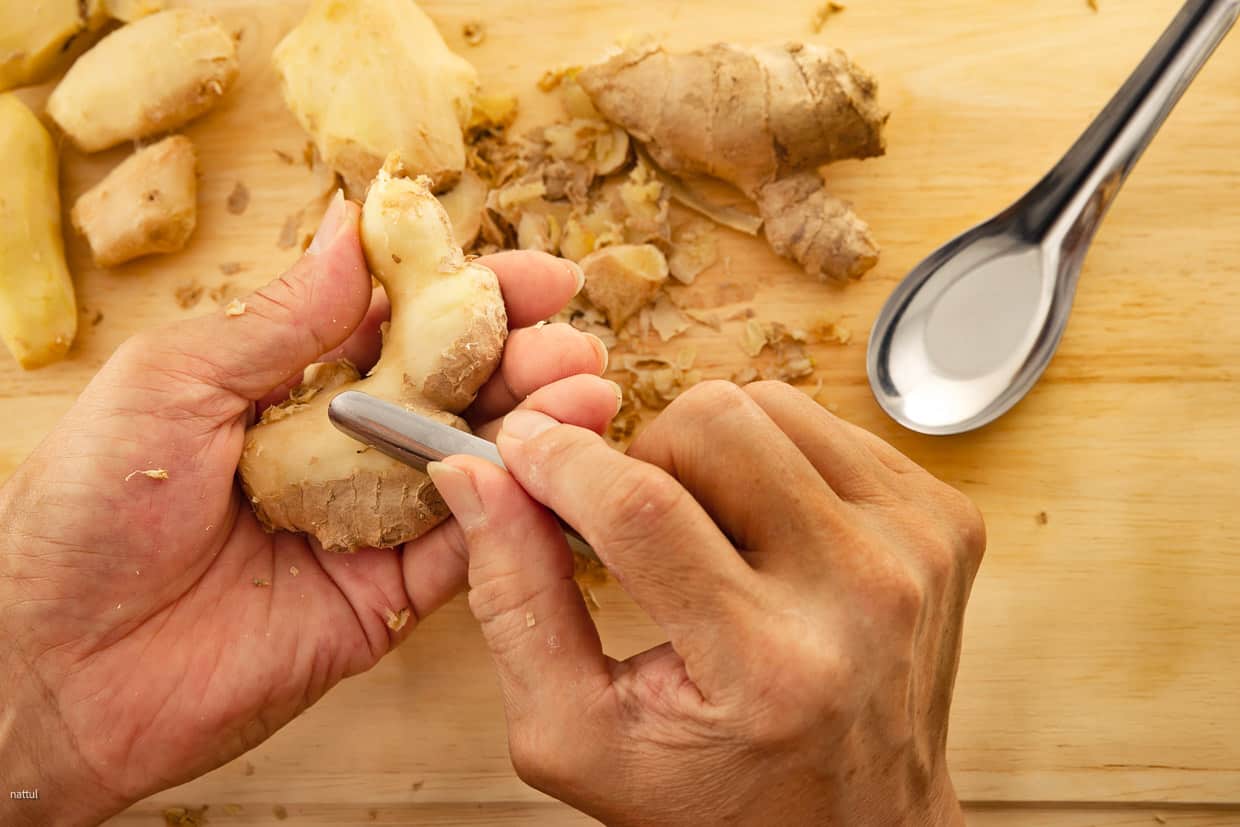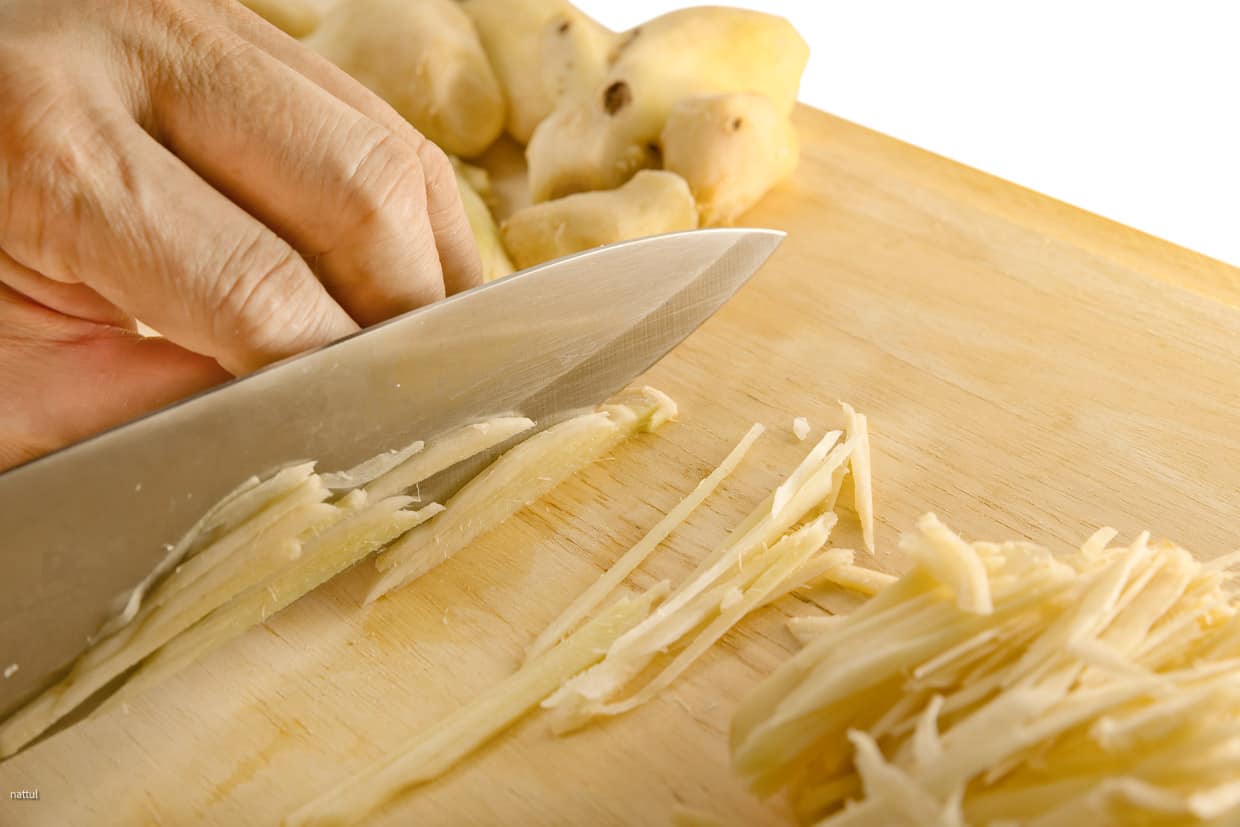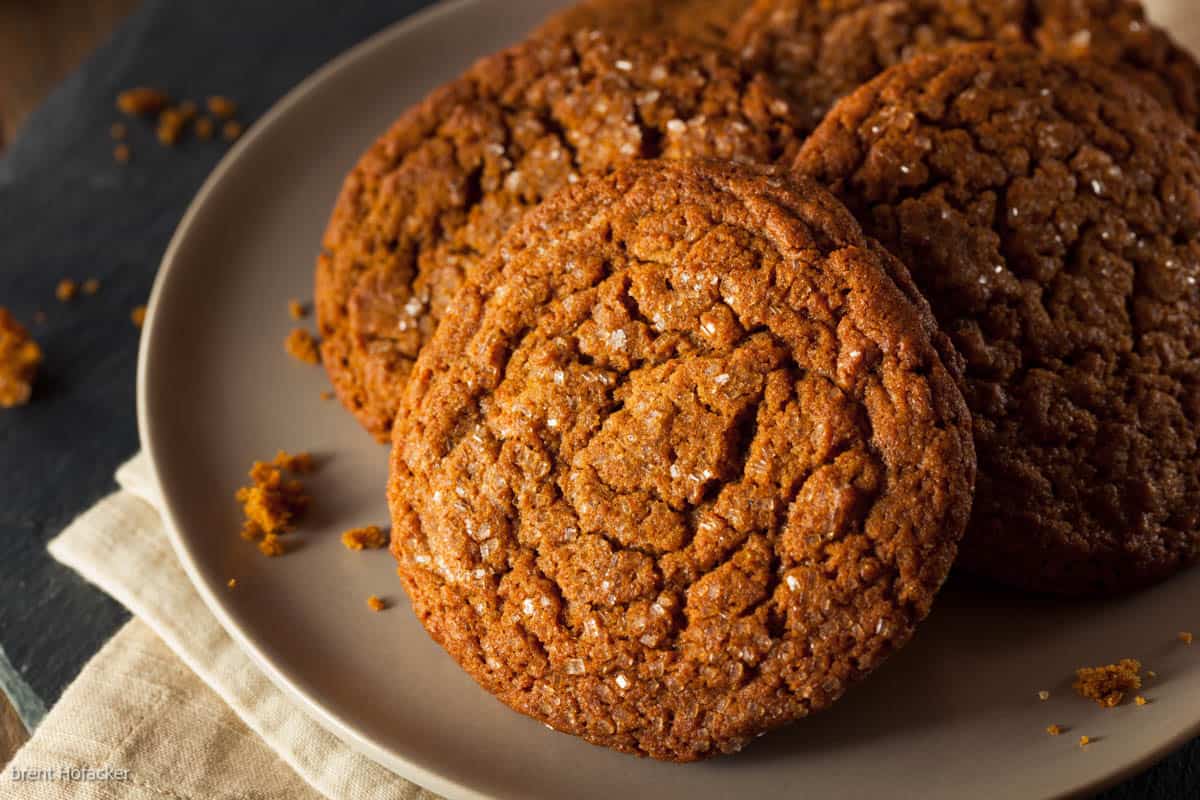Ginger is a captivating ingredient; full of spice and intrigue, it’s a sneaky scene-stealer in the kitchen. Gnarled and beige, it may not look like much, but this unassuming root is a powerhouse of flavor — tantalizing sweetness mingled with an underlying zingy, mouth-filling heat. There are countless ways to cook with fresh ginger to enliven your cooking and baking.

Ginger in the kitchen
One of the most fantastic things about ginger is how versatile it is. From savory dishes to sweet desserts, there’s often a place for fresh ginger. You’ll find it in many cuisines around the world.
Ginger is a popular aromatic in Asian cuisines like Chinese, Japanese, Korean and Indian, where it shows up in marinades, sauces, soups, stews, curries and dressings. You’ll find similar usage throughout the Pacific Rim, including Hawaiian and other Polynesian cuisines.
“Fresh ginger has a somewhat spicier, sweeter, and more complex flavor than dried ginger. I love using it in a variety of recipes, particularly in soups and stir-fries.”
— Gen La Rocca, Two Cloves Kitchen
In Africa, ginger is common in several regional cuisines, especially in North and East Africa. It’s a standard component of many spice blends for stews and marinades. And in the Caribbean, where food traditions draw heavily on African cuisines, ginger is used liberally in marinades for meats, spicy sauces, and flavorful beverages like ginger beer.
Fresh ginger is less common in European cooking, but dried, ground ginger stars in classic European desserts like gingerbread and ginger cookies and in liqueurs and aperitifs. In Eastern Europe, it shows up in some pickles and preserves. Substituting or adding fresh ginger can boost the flavors of these recipes even more.

How to prep fresh ginger
It might look intimidating if you’ve never handled fresh ginger before, but it’s easy to work with. Here’s how to prep it and cut it just right to use in whatever you’re cooking:
- Peel it: Grab a spoon and use the tip to scrape the thin skin off the ginger root. The skin is very thin, so it comes off easily, and the spoon tip is perfect for getting around the knobby contours. Note that peeling ginger is mostly an aesthetic choice as the peel has little or no discernable flavor.
- Grate it: Grating fresh ginger breaks it down into a pulp, releasing the flavorful juice. The fine texture blends well into sauces, marinades, dressings and batter for baking, distributing the ginger flavor evenly throughout the dish. Use a microplane grater, if you have one, for the best results.
- Chop it: Chopping ginger into small pieces or chunks gives a milder flavor compared to grating because less of the ginger’s surface area is exposed. Chopping is perfect when you want the ginger flavor to be a noticeable element of the dish but not be overpowering. The pieces of ginger will also add a bit of crunch and a burst of flavor when bitten into. Just make sure the pieces aren’t too large, or you might give diners too much of a jolt. Ginger is fibrous, so it can be a challenge to chop. Be sure to use a very sharp knife.
- Sliver or slice it: Larger pieces of ginger are great for steeping — either in a broth or liquid for tea or other beverages. You can cut ginger into coins or matchstick-size pieces. When making a stock, broth or beverage, add the pieces along with the other flavoring elements like vegetables, bones or tea.
- Mince it: Mincing ginger results in tiny pieces, but not as fine as grating. Mincing is a popular method for incorporating ginger into stir-fries, sautés and other dishes where you want the ginger to integrate fully with the other flavors but still have a bit of texture. As with chopping, you want to use a sharp knife to mince ginger effectively.
- Release the flavor: Heating fresh ginger releases its intense flavor. If you’re making a stir-fry, quickly saute the ginger in oil before adding other ingredients. Steeping it in hot liquid or adding it to a hot dish towards the end of cooking achieves a similar result.

FDL’S 75 Best Bites

Our cookbook with 75 tasty recipes will be your go-to kitchen companion for easy dinners with ad-free recipes right at your fingertips. Crafted by experienced chefs and recipe developers, this collection offers a treasure trove of tried-and-true dishes that make mealtime a breeze.
Get the Recipe: FDL’S 75 Best Bites
How to use ginger in savory dishes
Ginger has a heat that starts subtly and builds to a mouth-filling tingle. It’s slightly sweet, earthy and aromatic and is a boon to many savory dishes. Here are some favorite ways to use it:
- Meat and poultry marinades: Fresh ginger is a common component in many marinades. The spicy, aromatic notes can penetrate meat, poultry, seafood and tofu, providing a depth of flavor that is hard to achieve with other ingredients. Grated or minced ginger, combined with sesame oil, soy sauce and rice vinegar, gives a delightful Asian twist to your meat and poultry dishes. Combined with olive oil and cumin, it harkens to North Africa. Try it in dishes like kung pao chicken or Moroccan beef short ribs.
- Seafood: Fresh ginger pairs exceptionally well with seafood because it adds zing without being overbearing. Grate fresh ginger over fish or other seafood just as it comes off the grill or out of the steamer. Mild white fish and sweet shrimp, prawns or scallops take especially well to the pairing. You can also steam bivalves like clams or mussels in a broth made of coconut milk and fish stock flavored with ginger and other aromatics.
- Stir-fries: Like garlic, fresh ginger makes an excellent aromatic to add to stir-fries. It adds a radiant heat that enhances the sweetness of ingredients like shrimp or peppers. Or use it to counterbalance the richness of beef, lamb or pork. It features in dishes like pork fried rice or crispy beef.
- Curries: Fresh ginger brightens curry dishes from various cuisines, including Japanese and Indian curries. It’s less common in Thai curries, which often feature the related galangal root instead, but ginger makes a good substitute for galangal in a pinch.
- Soups and stews: In brothy soups, like chicken hot and sour soup, ginger adds brightness and aroma. Steep ginger slices in the liquid when making the stock and add more at the end of cooking for a zingy element. In creamy or thick soups, it adds a high note to balance the richness. Paired with sweet vegetables like carrots, peppers or squash, it contrasts and complements the sweetness. Or try it in a North African beef or lamb stew.
- Sauces: Ginger is great for adding a high note to sauces, like the spicy and meaty sauce for dan dan noodles or the spicy-sweet sauce for crispy beef. Or use it in salad dressings along with soy sauce or miso paste, sesame oil, sesame paste, rice vinegar or citrus juice.

Using fresh ginger in sweet recipes
If you think fresh ginger is just for savory dishes, think again. Dried ground ginger is a common ingredient in desserts like ginger snaps and gingerbread, but fresh ginger can give those classics a whole new vibe. Here are some ideas for using fresh ginger in sweet dishes:
- Fruit: A grating of fresh ginger livens up a regular fruit salad, giving it an exotic spin.
- Baked goods: Ground ginger brings a spicy depth to cakes, cookies and pies. But try adding minced fresh ginger, too, for a more pronounced kick.
- Beverages: Even in drinks, ginger works wonders. Indian chai often includes ginger with other intense spices and aromatics. You can also make a bracing tea by steeping fresh ginger in hot water. Stir up a lively cocktail featuring muddled ginger. Or add a fresh ginger slice to the blender when making your morning smoothie to add an invigorating warmth.
“Ginger is one of the best drink ingredients. I love to use fresh ginger to make ginger simple syrups for cocktails and homemade gingerale. It is an excellent addition to homemade kombucha too. I love the zing it provides as it balances sweet and sour ingredients alike. ”
— Susannah Brinkley Henry, Feast + West
Final thoughts
Ginger is truly a superstar in the world of cooking. Its unique fusion of spicy, sweet and warm flavors can enhance a dish in ways you’d never expect. Whether it’s elevating a rich soup or stew with a distinctive high note, adding a kick of spice to an everyday stir-fry or providing the perfect spicy note to counterbalance the sweetness of a dessert, fresh ginger is a versatile and rewarding ingredient to work with. So, grab a gangly branch of ginger on your next trip to the market and let your creativity run wild.
Robin Donovan is the author of more than 40 cookbooks, including the bestselling ”Campfire Cuisine,” ”Ramen Obsession,” and ”Ramen for Beginners.” A food writer, recipe developer, and food photographer, she is the creator of the food blog All Ways Delicious, where she shares easy recipes for the best dishes from around the world.